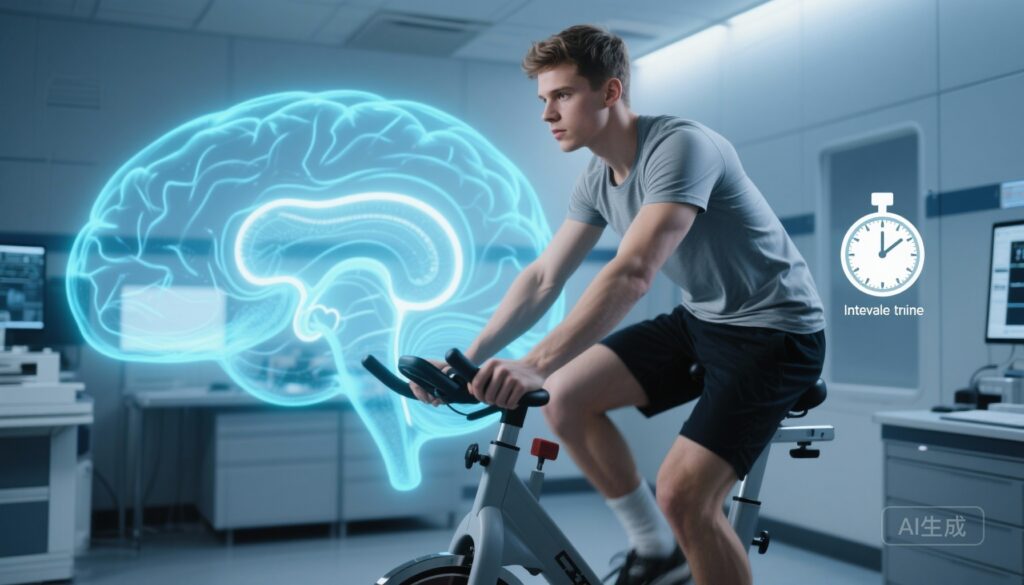Highlights
• A 12-week supervised high‑intensity interval training (HIIT) program did not improve a composite MRI measure of hippocampal integrity (volume, fractional anisotropy, N‑acetylaspartate) compared with supervised strength/resistance (SR) training in adults with moderate–severe cannabis use disorder (CUD).
• Exercise participation was feasible: 80% of participants completed the intervention and attended on average 80% of sessions.
• Although hippocampal integrity and cognitive/mental health outcomes did not improve, the intervention signaled potential to reduce cannabis craving and demonstrates acceptability of exercise as an adjunctive approach in CUD care.
Background: clinical context and unmet need
Cannabis use disorder (CUD) affects a sizable minority of regular users and is associated with adverse cognitive, functional, and neural outcomes. Chronic and heavy cannabis exposure has been linked to structural and functional changes in the hippocampus — a key region for episodic memory and affect regulation — and to measurable cognitive deficits in attention, memory, and executive function. These alterations create a rationale for interventions that target hippocampal integrity as a path to improving cognition and mental health in CUD.
Exercise is a promising neurorehabilitative strategy. Preclinical models show aerobic exercise increases hippocampal neurogenesis and synaptic plasticity, and human trials in older adults indicate aerobic programs can enlarge hippocampal volume and improve memory. High‑intensity interval training (HIIT) evokes larger acute increases in blood lactate and brain‑derived neurotrophic factor (BDNF) than lower‑intensity work, leading to the hypothesis that HIIT might preferentially drive plasticity-related changes in hippocampal structure and biochemistry and thereby mitigate CUD‑related impairment.
Study design and methods (BEAT trial)
The Brain Exercise and Addiction Trial (BEAT) was a single‑blind, randomized, comparator‑controlled clinical trial conducted at Monash University (BrainPark, Melbourne) between 2018 and 2022. The study enrolled adults with moderate to severe CUD; participants were not required to stop cannabis use. Key design elements:
- Population: 59 adults with moderate–severe CUD (mean age 27.0 years, SD 6.3; 80% male).
- Randomization: 1:1 to 12 weeks of supervised HIIT versus 12 weeks of supervised strength and resistance (SR) training; both delivered three times weekly and tailored by exercise physiologists.
- Intervention rationale: HIIT targeted a high‑lactate physiological state hypothesized to enhance neuroplastic signaling; SR served as an active, low‑lactate control.
- Primary outcome: composite hippocampal integrity index formed from three MRI‑based measures — anatomical volume, fractional anisotropy (FA), and N‑acetylaspartate (NAA) assessed at baseline and post‑intervention.
- Secondary outcomes: cognitive testing and mental health measures; adverse events were tracked.
Key findings
Participant flow and adherence: Of 59 randomized participants, 47 (80%) completed the 12‑week program. Mean attendance was 29 out of 36 sessions (≈80%), demonstrating feasibility of supervised exercise in this population despite ongoing substance use.
Primary outcome — hippocampal integrity composite
Hippocampal integrity did not improve after 12 weeks of HIIT compared with SR. The published trial report provides estimated marginal means (SE) for the composite index at baseline and post‑intervention:
- HIIT group: estimated marginal mean (SE) −0.14 (0.43) at baseline and 0.10 (0.45) after intervention.
- SR group: estimated marginal mean (SE) 0.38 (0.37) at baseline and −0.16 (0.37) after intervention.
These data indicate no statistically or clinically meaningful group × time benefit of HIIT on the composite hippocampal measure. The trial was powered to detect a change in a combined MRI index; however, confidence intervals around the estimates and the modest sample size limit inference about small effects.
Secondary outcomes — cognition, mental health, craving, and safety
Secondary cognitive and mental health measures did not show clear improvement following HIIT compared with SR. The report highlights, however, that exercise engagement itself may have benefits: participants tolerated the programs well and the interventions appeared to reduce cannabis craving in at least some measures, suggesting potential therapeutic value as an adjunctive strategy to support behavioral change.
Safety: Exercise programs were supervised and adverse events were recorded; no signal of significant exercise‑related harm is reported in the primary article, reinforcing feasibility of structured exercise in adults with CUD.
Interpretation and mechanistic considerations
The BEAT trial provides an important randomized test of whether targeted high‑intensity exercise can reverse or improve imaging biomarkers of hippocampal integrity in people with ongoing CUD. The negative finding — no improvement in the hippocampal composite — is informative and plausible for several reasons:
- Ongoing cannabis exposure: Participants continued to use cannabis during the intervention. If cannabis‑related neurobiological effects are sustained by continued use, exercise alone may be insufficient to reverse or overcome these effects within 12 weeks.
- Duration and dose: Most human trials showing hippocampal volumetric increases (for example, in older adults) involved longer durations, consistent aerobic dosing, and populations without ongoing neurotoxic exposure. A 12‑week period may be inadequate to detect structural or biochemical recovery in a young, actively using cohort.
- Composite endpoint complexity: The primary outcome combined three distinct modalities (volume, FA, NAA). Changes across different measures may not be synchronous; small improvements in one domain could be diluted when aggregated.
- Active control: Strength and resistance training is not physiologically inert with respect to the brain and may itself influence neurochemistry and cognition, reducing the contrast between groups.
Mechanistically, HIIT provokes transient increases in lactate and BDNF and has been associated with cognitive benefits in some studies. However, translation of acute molecular responses into durable MRI‑detectable structural or biochemical changes likely requires sufficient cumulative exposure, interaction with abstinence, or both.
Strengths and limitations
Strengths:
- Randomized, comparator‑controlled design with active control and supervised interventions.
- Multi‑modal MRI primary endpoint capturing structure, microstructure, and biochemistry.
- Feasibility demonstrated with good adherence and completion rates in a challenging clinical population.
Limitations:
- Relatively small sample size limits power to detect modest effects and subgroup analyses (for example by abstinence status).
- Participants continued cannabis use; absence of an abstinent subgroup or enforced cessation makes it difficult to separate recovery potential from ongoing exposure effects.
- Young sample may have different plasticity trajectories than older populations where exercise benefits have been documented.
- Composite primary outcome, while conceptually appealing, can obscure domain‑specific effects.
- Limited biomarker sampling (e.g., peripheral BDNF, lactate) reported in the primary paper constrains mechanistic interpretation.
Clinical and research implications
For clinicians working with patients with CUD, the trial offers three practical takeaways:
- Exercise programs are feasible, safe, and acceptable to many people with CUD and can be implemented under supervision in clinical or community settings.
- While HIIT alone did not restore hippocampal MRI measures in this trial, exercise may reduce craving and contribute to a broader relapse‑prevention or harm‑reduction strategy; clinicians can reasonably incorporate physical activity as an adjunctive, low‑risk intervention.
- Expectations about exercise as a rapid neurorestorative therapy should be tempered, particularly when substance use continues; integrated approaches that combine exercise with evidence‑based psychosocial or pharmacologic treatments and support for reduced use or abstinence may be necessary to realize neural recovery.
For researchers, next steps include larger trials with stratification by abstinence status, longer interventions, and richer biomarker panels (peripheral and central BDNF, lactate kinetics, inflammatory markers). Studies that test exercise as an adjunct to cessation programs or combine exercise with cognitive remediation could clarify whether multi‑modal approaches yield synergistic neural and clinical benefits.
Conclusion
The BEAT randomized clinical trial found that 12 weeks of supervised HIIT did not improve a composite measure of hippocampal integrity in adults with moderate–severe CUD who continued to use cannabis, compared with supervised strength/resistance training. Importantly, the study demonstrates exercise is feasible and acceptable in this population and suggests exercise may reduce craving. These findings refine expectations about exercise as a neural restorative therapy in active users and point toward combined or longer‑duration interventions and integration with cessation support as logical next steps.
Funding and trial registration
Trial registration: ClinicalTrials.gov Identifier: NCT04902092. Funding sources are reported in the primary publication (Richardson et al., JAMA Psychiatry 2025).
Selected references
1. Richardson KE, Suo C, Albertella L, et al. High‑Intensity Exercise and Hippocampal Integrity in Adults With Cannabis Use Disorder: A Randomized Clinical Trial. JAMA Psychiatry. 2025 Sep 10:e252319. doi:10.1001/jamapsychiatry.2025.2319.
2. Erickson KI, Voss MW, Prakash RS, et al. Exercise training increases size of hippocampus and improves memory. Proc Natl Acad Sci U S A. 2011;108(7):3017–3022.
3. van Praag H, Kempermann G, Gage FH. Running increases cell proliferation and neurogenesis in the adult mouse dentate gyrus. Nat Neurosci. 1999;2(3):266–270.
4. Yücel M, Solowij N, Resnick SM, et al. Regional brain abnormalities associated with long‑term heavy cannabis use. Neuropsychopharmacology. 2008;33(6):1050–1060.
5. Meier MH, Caspi A, Ambler A, et al. Persistent cannabis users show neuropsychological decline from childhood to midlife. Proc Natl Acad Sci U S A. 2012;109(40):E2657–E2664.
For clinicians and investigators, the BEAT findings emphasize pragmatic integration of exercise into CUD care while advocating for rigorously designed, larger trials to define when and how exercise can contribute to neural recovery.



